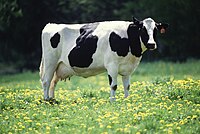
Photo from wikipedia
For infants in the first months of life, breast milk is a complete source of nutrition; however, it can also contain elements that are harmful to the infant. It is… Click to show full abstract
For infants in the first months of life, breast milk is a complete source of nutrition; however, it can also contain elements that are harmful to the infant. It is therefore critical for infant health to characterize breast milk. The aim of this study was to determine the intra- and inter-day variation of elements in breast milk, for which there is currently limited information, as a pilot study for a larger study. Firstly, we developed a simple and robust analytical method for the determination of multiple elements in breast milk. It was accurate (accuracy ranged from 98% to 107%) for measurement of 26 elements in breast milk by quadrupole inductively coupled plasma-mass spectrometry. Intra- and inter-day variation of elements, protein, and fat in breast milk was determined by analyzing breast milk collected from 11 women at 12 sampling points over three days and calculating intraclass correlation coefficients. Intraclass correlation coefficients showed that while some elements were consistent across time points (e.g., Sr, Ca, and Cu), others showed very high variability (e.g., As, Cd, and Ni). Correlation analyses between elements in breast milk showed strong relationships between those including Fe and Mo, Ca and Sr, and Cd and Fe.
Journal Title: Toxics
Year Published: 2022
Link to full text (if available)
Share on Social Media: Sign Up to like & get
recommendations!